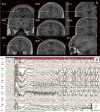Clinical Impacts of Stereotactic Electroencephalography on Epilepsy Surgery and Associated Issues in the Current Situation in Japan
- PMID: 37005247
- PMCID: PMC10241538
- DOI: 10.2176/jns-nmc.2022-0271
Clinical Impacts of Stereotactic Electroencephalography on Epilepsy Surgery and Associated Issues in the Current Situation in Japan
Abstract
Stereotactic electroencephalography (SEEG) is receiving increasing attention as a safe and effective technique in the invasive evaluation for epileptogenic zone (EZ) detection. The main clinical question is whether the use of SEEG truly improves outcomes. Herein, we compared outcomes in our patients after three types of intracranial EEG (iEEG): SEEG, the subdural electrode (SDE), and a combined method using depth and strip electrodes. We present here our preliminary results from two demonstrative cases. Several international reports from large epilepsy centers found the following clinical advantages of SEEG: 1) three-dimensional analysis of structures, including bilateral and multilobar structures; 2) low rate of complications; 3) less pneumoencephalopathy and less patient burden during postoperative course, which allows the initiation of video-EEG monitoring immediately after implantation and does not require resection to be performed in the same hospitalization; and 4) a higher rate of good seizure control after resection. In other words, SEEG more accurately identified the EZ than the SDE method. We obtained similar results in our preliminary experiences under limited conditions. In Japan, as of August 2022, dedicated electrodes and SEEG accessories have not been approved and the use of the robot arm is not widespread. The Japanese medical community is hopeful that these issues will soon be resolved and that the experience with SEEG in Japan will align with that of large epilepsy centers internationally.
Keywords: complication; epilepsy surgery; focal epilepsy; outcomes; stereotactic electroencephalography (SEEG).
Conflict of interest statement
All authors declare that there are no conflicts of interest (COIs) regarding this article according to the criteria of The Japan Neurosurgical Society. They have completed the self-reported registration of their COI status to the society.
Figures



Similar articles
-
Comparative effectiveness of stereotactic, subdural, or hybrid intracranial EEG monitoring in epilepsy surgery.J Neurosurg. 2024 Mar 8;141(2):372-380. doi: 10.3171/2024.1.JNS232560. Print 2024 Aug 1. J Neurosurg. 2024. PMID: 38457804
-
The stereotactic approach for mapping epileptic networks: a prospective study of 200 patients.J Neurosurg. 2014 Nov;121(5):1239-46. doi: 10.3171/2014.7.JNS132306. Epub 2014 Aug 22. J Neurosurg. 2014. PMID: 25148007
-
Comparative Effectiveness of Stereotactic Electroencephalography Versus Subdural Grids in Epilepsy Surgery.Ann Neurol. 2021 Dec;90(6):927-939. doi: 10.1002/ana.26238. Epub 2021 Oct 14. Ann Neurol. 2021. PMID: 34590337 Free PMC article.
-
Patient phenotypes and clinical outcomes in invasive monitoring for epilepsy: An individual patient data meta-analysis.Epilepsy Behav. 2020 Jan;102:106652. doi: 10.1016/j.yebeh.2019.106652. Epub 2019 Nov 23. Epilepsy Behav. 2020. PMID: 31770717 Review.
-
Depth versus surface: A critical review of subdural and depth electrodes in intracranial electroencephalographic studies.Epilepsia. 2024 Jul;65(7):1868-1878. doi: 10.1111/epi.18002. Epub 2024 May 9. Epilepsia. 2024. PMID: 38722693 Review.
Cited by
-
Hemodynamic and electrophysiological responses of the human amygdala during face imitation-a study using functional MRI and intracranial EEG.Cereb Cortex. 2024 Jan 14;34(1):bhad488. doi: 10.1093/cercor/bhad488. Cereb Cortex. 2024. PMID: 38112625 Free PMC article.
-
Usefulness of Robotic Stereotactic Assistance (ROSA®) Device for Stereoelectroencephalography Electrode Implantation: A Systematic Review and Meta-analysis.Neurol Med Chir (Tokyo). 2024 Feb 15;64(2):71-86. doi: 10.2176/jns-nmc.2023-0119. Epub 2024 Jan 15. Neurol Med Chir (Tokyo). 2024. PMID: 38220166 Free PMC article.
-
Endovascular electroencephalography (eEEG) can detect the laterality of epileptogenic foci as accurately as subdural electrodes.Heliyon. 2024 Feb 1;10(3):e25567. doi: 10.1016/j.heliyon.2024.e25567. eCollection 2024 Feb 15. Heliyon. 2024. PMID: 38327423 Free PMC article.
-
Awake Craniotomy in Epilepsy Surgery: A Case Series and Proposal for Three Different Scenarios.Brain Sci. 2024 Sep 25;14(10):958. doi: 10.3390/brainsci14100958. Brain Sci. 2024. PMID: 39451973 Free PMC article.
References
-
- Bancaud J, Angelergues R, Bernouilli C, et al. : Functional stereotaxic exploration (SEEG) of epilepsy. Electroencephalogr Clin Neurophysiol 28: 85-86, 1970 - PubMed
-
- Cardinale F, Cossu M, Castana L, et al. : Stereoelectroencephalography: Surgical methodology, safety, and stereotactic application accuracy in 500 procedures. Neurosurgery 72: 353-366, 2013 - PubMed
-
- González-Martínez J, Bulacio J, Thompson S, et al. : Technique, results, and complications related to robot-assisted stereoelectroencephalography. Neurosurgery 78: 169-180, 2016 - PubMed
-
- Talairach J, Bancaud J: Stereotaxic approach to epilepsy methodology of anatomo-functional stereotaxic investigations. Prog Neurol Surg Basel 297-354, 1973
-
- Bancaud J: Surgery of epilepsy based on stereotactic investigations–the plan of the SEEG investigation. Acta Neurochir Suppl 30: 25-34, 1980 - PubMed

